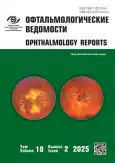Nd:YAG-лазерная мембранотомия при длительно существующем премакулярном кровоизлиянии (клинический случай)
- Авторы: Суетов А.А.1,2, Докторова Т.А.1
-
Учреждения:
- Санкт-Петербургский филиал Национального медицинского исследовательского центра «Межотраслевой научно-технический комплекс “Микрохирургия глаза” им. акад. С.Н. Фёдорова»
- Государственный научно-исследовательский испытательный институт военной медицины
- Выпуск: Том 18, № 2 (2025)
- Страницы: 69-76
- Раздел: Клинические случаи
- URL: https://bakhtiniada.ru/ov/article/view/312614
- DOI: https://doi.org/10.17816/OV640003
- EDN: https://elibrary.ru/JRSACG
- ID: 312614
Цитировать
Аннотация
Премакулярные кровоизлияния сопровождаются внезапным значительным снижением зрения и могут быть вызваны различными причинами, среди которых наиболее частыми являются пролиферативная ретинопатия при диабетической офтальмопатии, ишемических ретинальных венозных окклюзиях, ретинальных артериальных макроаневризмах и ретинопатии Вальсальвы. Небольшие по объёму кровоизлияния (менее 3 диаметров диска зрительного нерва) часто подвергаются полному самостоятельному разрешению, но при больших кровоизлияниях и их локализации под внутренней пограничной мембраной сетчатки вероятность самостоятельного разрешения значительно снижается, и повышаются риски развития осложнений, связанных с токсическими эффектами продуктов распада гемоглобина. Основным методом лечения в таких случаях служат Nd:YAG-лазерная мембрано- или гиалоидотомия, которые позволяют эффективно и безопасно дренировать кровь в стекловидное тело, где она полностью резорбируется. В статье представлен клинический случай длительно существующего премакулярного кровоизлияния из ретинальной артериальной макроаневризмы, при котором проведение Nd:YAG-лазерной мембранотомии даже в отдалённом периоде от момента кровоизлияния позволило не только значительно повысить зрительные функции, но и избежать проведения инвазивных витреальных вмешательств. Наблюдение в течение 3 лет после лечения не выявило развития осложнений лечения.
Ключевые слова
Полный текст
Открыть статью на сайте журналаОб авторах
Алексей Александрович Суетов
Санкт-Петербургский филиал Национального медицинского исследовательского центра «Межотраслевой научно-технический комплекс “Микрохирургия глаза” им. акад. С.Н. Фёдорова»; Государственный научно-исследовательский испытательный институт военной медицины
Автор, ответственный за переписку.
Email: ophtalm@mail.ru
ORCID iD: 0000-0002-8670-2964
SPIN-код: 4286-6100
канд. мед. наук
Россия, Санкт-Петербург; Санкт-ПетербургТаисия Александровна Докторова
Санкт-Петербургский филиал Национального медицинского исследовательского центра «Межотраслевой научно-технический комплекс “Микрохирургия глаза” им. акад. С.Н. Фёдорова»
Email: taisiiadok@mail.ru
ORCID iD: 0000-0003-2162-4018
SPIN-код: 8921-9738
MD
Россия, Санкт-ПетербургСписок литературы
- Shkvorchenko DO, Kakunina SA, Norman KS, et al. The main aspects of etiopathogenesis, diagnosis and treatment of subhyaloid hemorrhages. Fyodorov Journal of Ophthalmic Surgery. 2021;4:70–74. doi: 10.25276/0235-4160-2021-4-70-74 EDN: VHGCTT
- Malov IA. Yag-laser hyaloidotomy in the treatment of premacular hemorrhages. Reflection. 2019;(1):28–31. doi: 10.25276/2686-6986-2019-1-28-31 EDN: UXLDBC
- Khadka D, Bhandari S, Bajimaya S, et al. Nd: YAG laser hyaloidotomy in the management of Premacular Subhyaloid Hemorrhage. BMC Ophthalmol. 2016;16:41. doi: 10.1186/s12886-016-0218-0
- Brar AS, Ramachandran S, Takkar B, et al. Characterization of retinal hemorrhages delimited by the internal limiting membrane. Indian J Ophthalmol. 2024;72(S1):S3–S10. doi: 10.4103/IJO.IJO_266_23
- Pitkänen L, Tommila P, Kaarniranta K, et al. Retinal arterial macroaneurysms. Acta Ophthalmol. 2014;92(2):101–104. doi: 10.1111/AOS.12210.
- Krylova IA, Fabrikantov OL. Retinal arterial macroaneurysm: diagnostic difficulties. Journal of Volgograd State Medical University. 2019;(4):85–90. doi: 10.19163/1994-9480-2019-4(72)-85-90 EDN: MQKDNN
- Singh D, Tripathy K. Retinal macroaneurysm. In: StatPearls. Treasure Island (FL): StatPearls Publ.; 2024.
- Halfter W, Sebag J, Cunningham ET. Vitreoretinal interface and inner limiting membrane. In: Sebag J, editor. Vitreous. New York: Springer New York; 2014. P. 165–191. doi: 10.1007/978-1-4939-1086-1_11
- Wang S, Wu X. Early treatment with Nd: YAG laser membranotomy and spectral-domain OCT evaluation for Valsalva retinopathy. Int J Clin Exp Med. 2016;9(8):15135–15145.
- Hussain RN, Stappler T, Hiscott P, Wong D. Histopathological changes and clinical outcomes following intervention for sub-internal limiting membrane haemorrhage. Ophthalmologica. 2020;243(3):217–223. doi: 10.1159/000502442.
- Rennie CA, Newman DK, Snead MP, Flanagan DW. Nd:YAG laser treatment for premacular subhyaloid haemorrhage. Eye (Lond). 2001;15:519–524. doi: 110.1038/EYE.2001.166
- Chung J, Park Y-H, Lee Y-C. The effect of Nd: YAG laser membranotomy and intravitreal tissue plasminogen activator with gas on massive diabetic premacular hemorrhage. Ophthalmic Surg Lasers Imaging. 2008;39(2): 114–120. doi: 10.3928/15428877-20080301-06
- Yang CM, Chen M-S. Tissue plasminogen activator and gas for diabetic premacular hemorrhage. Am J Ophthalmol. 2000;129(3):393–394. doi: 10.1016/S0002-9394(99)00393-1
- Brar AS, Ramachandran S, Padhy SK. Triple trouble: sequelae of Nd: YAGphotodisruptive laser membranotomy for Valsalva retinopathy. Can J Ophthalmol. 2022;57(1):E14–E16. doi: 10.1016/J.JCJO.2021.05.005
- Goker YS, Tekin K, Ucgul Atilgan C, et al. Full thickness retinal hole formation after Nd:YAG laser hyaloidotomy in a case with valsalva retinopathy. Case Rep Ophthalmol Med. 2018;2018:1–4. doi: 10.1155/2018/2874908
Дополнительные файлы










